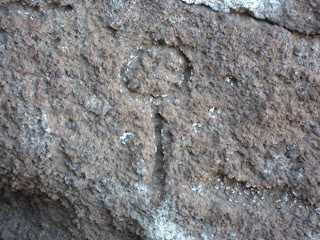
Sept 8, 2009 - I was wondering if anyone within your group could help me on the interpretation of the glyph I have attached to this email. The photo is orientated correctly (top is up). It is located at the Forest Service Office at Fillmore, Utah. It was taken from it’s original site up Chalk Creek Canyon near some hieroglyphs some years ago.
Any help would be greatly appreciated. Thank you.
Steve Shaffer, President The We Nooch Society
From: Dr. R.M. de Jonge, Wentholtweg 8, 7214 EG Epse, The Netherlands
Tel.: 031-575-492813
Email: rmdejonge@gmx.net
Email: drsrmdejonge@hotmail.com
Website: www.howthesungod.com
September 13, 2009
Dear Jim Leslie,
Dear Steve Shaffer,
(Turn the photo of the petroglyph upside down.)
THE UTAH PETROGLYPH
It is the carving of a man. He has two legs, his body consists of two (or three) parts in the center, and his head is on top of it. Near his heart is a hole in the rock. It represents the site of the carving near Fillmore, Utah, at 39°N. His head is a square, and it is part of a row of four squares, because one degree higher is the latitude of 40°N. The man is a king of the Fourth Dynasty. Below his head (near his heart) is also a square, so it is the fifth king Menkaura (of the Fourth Dynasty), who discovered America via the Southern Aleutian Islands, at the complementary latitude of 90-39= 51°N.
Around the hole in the rock is a big eye, and the hole itself is the pupil (iris) of it. It is the eye of the SunGod Ra. He appears at the latitude of the holy Tropic of Cancer, at 23°N. His head is one degree higher, at 24°N, so king Menkaura also discovered the Crossing of the Bering Strait, at the complementary latitude of 90-24= 66°N.
The five squares, just mentioned, encode the Southern Crossing of the Atlantic to Cape Sao Rock (the Holy Rock), Brazil, at 5°S, discovered at the Fifth Dynasty. The two legs of the man encode its sailing distance, of 2 Moiras, or 20°, as discovered by the second King Sahura (of the Fifth Dynasty).
His body consists of two large parts in the center, so he also discovered the return route from Newfoundland to the West Azores. These two islands are located at the level of the site of this petroglyph, at 39°N. Counted from the left, the head of the man is the second box, confirming that this second Crossing was discovered by the second king Sahura.
Counted from the right the head of the man is the third box. So, the Northern Crossing, from the Shetland Islands, via the south point of Greenland, to Cape Chidley, Canada, was discovered by the third king Nefererkare. These three kings came from the Nile Delta, at 30°N. The Northern Crossing via the three landpoints happened at the complementary latitude of the Nile Delta, at 90-30= 60°N. It was the third Crossing of the Atlantic. The body of the man consists of two large parts and a small part, so three parts, confirming this third king.
The Utah petroglyph shows a man, consisting of two legs, three central body parts, and a head, with three boxes. These (2+3+1+3 =) 9 parts show the latitude of the island of Bermuda, 9° above the Tropic of Cancer, at 23+9= 32°N. So, the return route across the Atlantic via Ber-muda to the 9 islands of the Azores was discovered by the 9th king Unas of the Fifth Dynasty.
The Utah carving consists of 9 parts. However, it also has a hole, and at both sides two arms, which show that the petroglyph dates from the 9+3= 12th Dynasty (Middle Kingdom).
Regards,
Reinoud de Jonge
The Netherlands
P.S.
De Jonge, R.M., “The Discovery of Three Continents (Santo Stefano, North Sardinia, Italy, c.2300 BC)”, Ancient American, Vol.12, No.76, pgs.28-29 (2007)
From: Frank Joseph [mailto:frankjoseph44@gmail.com]
Sunday, September 13, 2009 11:54 PM
To: John White: johnwhite@columbus.rr.com
Subject: Re: FW: Help with Glyph
Looks very modern. Frank
From Steve Shaver ssgoldenpath@ancienttreasurehunters.com
Seotenber 14m 2009 5:57 PM
It’s not modern. The glyph was first photographed by Frank Beckwith back in 1929. It was covered in lichens and hardly noticeable!
From: David Grant Stewart Sr: dstewart@amnix.com
Sunday, September 13, 2009 7:39 PM
This is Olmec Hieratic.












